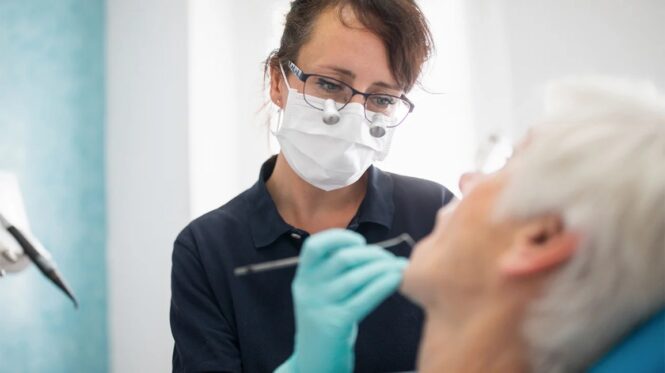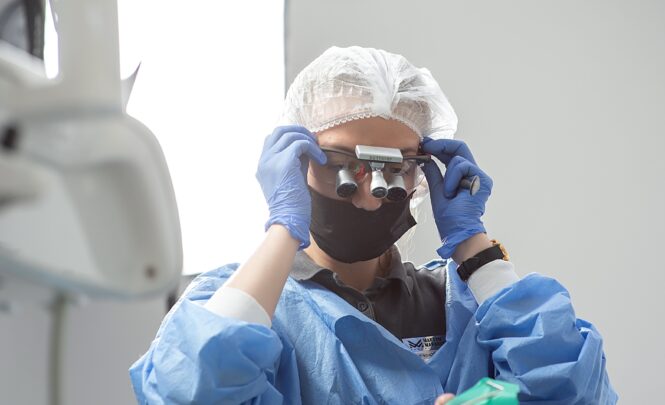As dental professionals, one of the most important tools we use is our eyesight. We rely heavily on our eyes to diagnose and treat dental conditions effectively. However, the human eye has its limitations, and without the aid of technology, it can be challenging to see everything clearly. This is where dental loupes come in. In this article, we’ll discuss why investing in dental loupes is worth it for future dental professionals.
Introduction to Dental Loupes
The Dental loupes are magnification devices that attach to eyewear, providing an enhanced view of the oral cavity. They come in different magnification powers, typically ranging from 2.5x to 6.0x. A Dental Headlight provides a more detailed and accurate view of the dental anatomy, which can help dental professionals to make better diagnoses and perform procedures with greater precision.
Benefits of Dental Loupes

There are numerous benefits of using dental loupes, including
1. Enhanced Visualization
One of the primary benefits of using dental loupes is enhanced visualization. Dental loupes magnify the working area, allowing dental professionals to see even the smallest details of the oral cavity. This enhanced visualization can help to identify problems that might be missed by the naked eye.
2. Improved Ergonomics
Dental professionals often spend long hours working in a seated position, which can lead to neck and back pain. Dental loupes improve ergonomics by allowing the dental professional to maintain a more upright posture while working. This can help to reduce strain on the neck and back and decrease the risk of musculoskeletal disorders.
3. Better Treatment Outcomes
Dental loupes can help to improve treatment outcomes by allowing dental professionals to perform procedures with greater precision. This precision can lead to better restorations, fewer complications, and better patient outcomes overall.
4. Cost-Effective
While dental loupes can be a significant investment, they are ultimately cost-effective. Investing in dental loupes can lead to better treatment outcomes, which can result in increased patient satisfaction and referrals. Additionally, dental loupes can help to reduce the risk of work-related injuries, which can be costly to both the dental professional and the practice.
5. Improved Communication
Dental loupes can enhance communication between dental professionals and their patients. By providing a more detailed view of the oral cavity, dental professionals can better explain diagnoses and treatment options to their patients, which can lead to increased patient trust and satisfaction.
6. Increased Efficiency
Dental loupes can help to increase efficiency in dental procedures by allowing dental professionals to work more quickly and accurately. This increased efficiency can lead to more productive and profitable practices.
Types of Dental Loupes

There are two primary types of dental loupes: through-the-lens (TTL) and flip-up loupes. TTL loupes are mounted directly onto the eyeglass lens, providing a more secure and stable viewing experience. Flip-up loupes, on the other hand, attach to the frame of the eyewear and can be flipped up when not in use. Both types of loupes have their advantages and disadvantages, and the choice ultimately comes down to personal preference.
Factors to Consider When Choosing Dental Loupes

When choosing the dental loupes, there are several factors to consider, including:
1. Magnification
The magnification power of the loupes should be appropriate for the type of work being performed. Higher magnification loupes are typically used for more intricate procedures, while lower magnification loupes are better suited for general dentistry.
2. Field of View
The field of view refers to the area visible through the loupes. A larger field of view can be helpful for performing procedures, while a smaller field of view can be more suitable for diagnostic work.
3. Working Distance
The working distance is the distance between the dental professional and the patient. The working distance should be comfortable and appropriate for the type of work being performed.
4. Weight
The weight of the loupes should be comfortable for the dental professional to wear for extended periods. If the weight is too much the the doctor may feel strain on his or her eyes and neck.
5. Depth of Field
The depth of field is the distance between the nearest and farthest points that appear in focus. A larger depth of field can be beneficial for performing procedures that require a broader view, while a smaller depth of field can be more appropriate for working on specific areas.
6. Frame Style
The frame style can impact the overall comfort and stability of the loupes. Different frame styles, such as wrap-around, sport, or classic frames, can offer varying levels of support and adjustability.
7. Light Source Compatibility
Some dental loupes are compatible with built-in or attachable light sources, which can provide additional illumination and enhance visualization. It’s important to consider whether you need this feature and if it’s available for the loupes you’re interested in.
8. Quality and Durability
Investing in high-quality dental loupes can be a significant investment, but it’s important to choose a pair that is built to last. Consider the materials used, the level of craftsmanship, and the manufacturer’s warranty when making your decision.
9. Cost
While cost shouldn’t be the only consideration, it’s essential to choose dental loupes that are within your budget. Consider the features you need and prioritize those that are most important for your practice.
By considering these factors, you can choose dental loupes that provide the optimal combination of comfort, functionality, and affordability for your needs.
Wrapping Up
Investing in dental loupes is worth it for dental professionals, including their clients, as it can significantly improve their ability to diagnose and treat oral health issues and offer better service. However, unexpected dental emergencies can be quite expensive. That’s why many dentists in Texas work with various dental insurance providers to help their patients access affordable care and ensure that they receive the necessary treatments without financial strain.
The Dental Loupes offers numerous benefits, including enhanced visualization, improved ergonomics, and better treatment outcomes. There are different types of dental loupes to choose from, and several factors to consider when selecting the right pair. While dental loupes may be a significant investment, they ultimately pay off in improved patient outcomes, reduced risk of work-related injuries, and increased efficiency and accuracy in dental procedures.
 Imagup General Magazine 2024
Imagup General Magazine 2024



